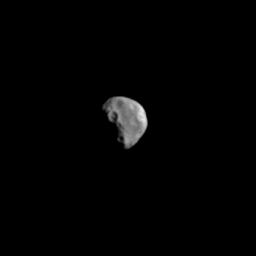
|
High Resolution View of Dactyl
- Click the image above for a larger view
- Full-Res JPEG (700 x 700) (7.7 kB)
- Full-Res TIFF (700 x 700) (22.1 kB)
Caption:
This image is the most detailed picture of the recently discovered natural satellite of asteroid 243 Ida taken by the Galileo Solid-State Imaging camera during its encounter with the asteroid on August 28, 1993. Shuttered through the camera's broadband clear filter as part of a 30-frame mosaic designed to image the asteroid itself, this frame fortuitously captured the previously unknown moon at a range of about 3,900 kilometers (2,400 miles), just over 4 minutes before the spacecraft's closest approach to Ida. Each picture element spans about 39 meters (125 feet) on the surface of the moon. More than a dozen craters larger than 80 meters (250 feet) in diameter are clearly evident, indicating that the moon has suffered numerous collisions from smaller Solar System debris during its history. The larger crater on the terminator is about 300 meters (1,000 feet) across. The satellite is approximately egg-shaped, measuring about 1.2 x 1.4 x 1.6 kilometers (0.75 x 0.87 x 1 mile). At the time this image was shuttered, Ida was about 90 kilometers (56 miles) away from the moon, outside this frame to the left and slightly below center. This image was relayed to Earth from Galileo on June 8, 1994.
Background Info:
The Galileo project, whose primary mission is the exploration of the Jupiter system in 1995-97, is managed for NASA's Office of Space Science by the Jet Propulsion Laboratory.
Cataloging Keywords:
| Name | Value | Additional Values |
|---|---|---|
| Target | 243 Ida I (Dactyl) | 243 Ida, Jupiter |
| System | Main Belt | 243 Ida, Main Belt |
| Target Type | Satellite | Asteroid, Planet |
| Mission | Galileo | |
| Instrument Host | Galileo Orbiter | |
| Host Type | Orbiter | |
| Instrument | Solid-State Imaging (SSI) | |
| Detector | ||
| Extra Keywords | Collision, Crater, Grayscale | |
| Acquisition Date | ||
| Release Date | 1996-09-12 | |
| Date in Caption | 1993-08-28 | 1994-06-08 |
| Image Credit | NASA/JPL | |
| Source | photojournal.jpl.nasa.gov/catalog/PIA00297 | |
| Identifier | PIA00297 | |
